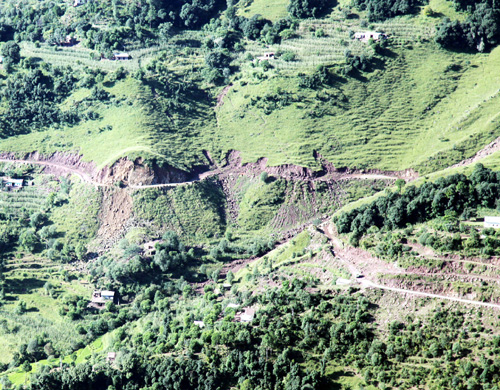Nazam Din Mir & Priyanka Chatterjee
In Jammu and Kashmir, this month has been about elections, terrorist attacks and ceasefire violations. All this has completely wiped out the floods from the headlines that have had hit the state in September leaving its people completely shattered.
Still trying to come to terms with life, the drastic year isn’t yet over for the affected people. Winter in the mountains has settled early this year. Are they geared up enough to face the particularly challenging winters this year?
Two hundred and fifty kilometers from Jammu, the winter capital of Jammu and Kashmir, lies the border district of Poonch, always in the news for ceasefire violations. Tucked away in the mighty PirPanjal Mountains, Poonch is one of the most backward districts of the state with its rural population still living without access to even basic amenities. The floods have pushed them back by a few decades more. The challenges ahead have snatched their peace of mind – a peaceful winter ahead looks like a remote possibility.
Fifty-year old HusanJaanof Village Khanetar, hardly ten fifteen kilometers from Poonch town, completed the construction of her house recently, meticulously timed in preparation for a warm season ahead. But the floods have left her family devastated, and completely unprepared for the chilling season.
“We had invested a sum of 5-6 lakh rupees to build this house when I had come home in June this year.The water had engulfed the entire house with cracks all over,” says HusanJaan’s son, Sadaqat Hussain, who works with the BSF and is currently posted in Punjab.Although they have managed to repair the cracks on a temporary basis, they live in constant fear of further damage during the impending days of snowfall.
“We have been living at our relative’s place ever since our house was damaged,” says Shenaz Bi, 35. Her husband works for the Army and is posted in Assam. The sight of her house is disheartening. There are distinct cracks all over.
Almost every house in Khanetar has a similar problem. “The winters are going to be harsh and when it snows it is going to be even more difficult,” adds the ex Sarpanch,Chowdhary Abdul Latif.
Places like Mandi, Loran, Surankote, Khaneter, Shahpur, Sawjian and Buffliaz experience snowfall every year. It is a well-known fact that when the snow enters the cracks that are left unfilled and neglected, the moisture, water, snow and ice penetrate inside the walls. The snow and ice further expands the walls of the crack, which maybecome hazardous and can lead to sliding.
When asked whether Poonch is ready for the harsh winters M H Malik, Deputy Commissioner responded saying, “We are very well prepared for the winters, but our prime concern are areas like Mandi and Surankote, since these areas experience quite heavy snowfall.”
He further added, “It is not just the cracks that are worrisome, even the weight of the snow on the roofs of these fragile houses may pose a great threat.”
Surankote Tehsil, one of the worst affected by the floods, is 27 kilometers to the east of Poonch city and approximately 221 kilometers away from the winter capital, Jammu. 1230 houses were damaged partially or fully in Surankote alone.
“It always snows in Surankote, but the snowfall this year can be life threatening,” says the Sarpanch, Chowdhary Aslam Hussain from Murrah, Surankote Tehsil.
“The floods have already created havoc this year, but with regard to the preparations for winter and snowfall, the Government has not taken any initiatives as yet,” he adds.
According to the National Institute of Disaster Management’s profile for Jammu and Kashmir, the state is prone to flashfloods. The state is a multi hazard prone region with natural disasters like earthquakes, floods, landslides, avalanches, high velocity winds and snow storms, besides man-made disasters including road accidents and fires.
The Home Ministry says these floods hit several villages across the state and 390 villages had been completely submerged. Other reports peg the figure at 2600 affected villages, of which 390 villages in Kashmir were completely submerged. 1225 villages were partially affected and 1000 villages were affected in Jammu Division. Many parts of Srinagar, including the Border Security Force (BSF) HQ in Sanant Nagar & Army containment in BadamBagh, were inundated, and vital roads were submerged.
The state government had approved a three-tier Disaster Management Policy in February 2012 to put in place a proper mechanism for rescue, relief and rehabilitation of disaster victims. But according to sources, the state government could not create a separate department which would only deal with disasters. Sources say that disaster management in Jammu and Kashmir is not managed by an autonomous body, but by respective divisional commissioners or deputy commissioners of the district.
The Centre for Science and Environment sees this disaster as another manifestation of an extreme weather event – induced by climate change. The Jammu & Kashmir disaster was caused by an event classified in the ‘very heavy rainfall’ category. The fear is that due to climate change, this can become the new normal.
The immediate focus in Jammu and Kashmir should be strong and well planned disaster management teams and good weather forecasts. We need to tackle disasters through better adaptation of climate change and long-term disaster prevention measures. Failure to do so threaten to make disasters of this scale a regular feature.
The Prime Minister visited the state on Diwali this year and announced an additional relief package of Rs 745 crore for rebuilding of damaged homes and hospitals in the flood affected state. He added that he had immediately announced a relief package of Rs 1,000 crore after the floods. It has been close to three months already, but when this money reaches deserving hands remains an unanswered question. (Charkha Features)
Major Disasters In J&K
Sr No Events Date
b Snow Blizzard (KulgamDist) Feb 2005
b Kashmir Earthquake Oct 2005
b Leh Cloud burst June 2011
b Floods of J&K Sept 2014


